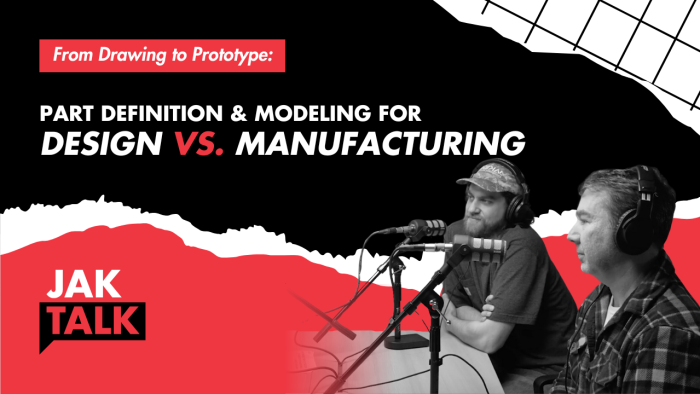Bridging the Design-Manufacturing Divide: A Key to Competitive Advantage

The synergy between design and manufacturing teams is a critical determinant of the project’s success and the company’s competitiveness. This article delves into the intricate balance between part definition, modeling for design, and the practical realities of manufacturing, a theme that resonates deeply with professionals across the spectrum, from engineers to business leaders.
This article is a recap of JAKTALK episode #2. You can watch the full episode on YouTube.
The Essence of Collaboration
At the heart of this discussion is the collaboration between different facets of the project process, particularly those involved in design and manufacturing. This collaboration is not just about coexistence but about leveraging the unique perspectives of each domain to solve problems and innovate to find new and creative solutions.
From Conception to Production
The transition from initial designs, sometimes characterized by ambitious engineering concepts, to manufacturable products is where challenges often arise. These challenges range from material limitations and production capabilities to cost considerations and time constraints. An illustrative example is the experience of working on systems requiring components that exceed the production capabilities of local mills, highlighting the fundamental limitations imposed by manufacturing realities.
This balance is not just about feasibility; it’s also about strategic decision-making. Early design decisions can significantly impact the producibility, cost, and, ultimately, the market success of a product. Therefore, understanding and addressing these challenges from the get-go is essential for aligning design aspirations with manufacturing realities. Additionally, the importance of good communication between the designer and the end manufacturer cannot be understated. A good flow of communication throughout the whole process can help the team avoid or work through challenges.
Strategies for Harmonizing Design and Manufacturing
A key strategy for bridging the gap between design and manufacturing is adopting a design for manufacturability (DFM) approach. This is easier said than done. This involves design engineers working closely with manufacturing teams from the earliest stages of product development to ensure that designs are optimized for manufacturing processes, materials, and cost constraints.
Moreover, leveraging technologies such as CAD and 3D printing for rapid prototyping can facilitate a more iterative and collaborative design process. This approach allows for early detection of design issues that may impact manufacturability, enabling quicker adjustments before low-rate production or full-rate production begins.
The Role of Communication and Continuous Learning
Effective communication is paramount in ensuring a smooth transition from design to manufacturing. Regular meetings, updates, and open channels for feedback between designers, engineers, and manufacturing teams can help identify potential issues early, foster mutual understanding, and drive collective problem-solving efforts.
Additionally, a culture of continuous learning and curiosity can empower teams to explore new methods, tools, and technologies that enhance both design innovation and manufacturing efficiency. Encouraging team members to broaden their understanding of each other’s domains can lead to more informed decisions and creative solutions.
This is a key difference in JAKTOOL’s process. Our teams are often much more collaborative than in-house manufacturing departments or manufacturing shops. We care about the project just as much as our customers do. Our drive for perfection and innovative, creative solutions for problems as they arise fosters an environment of collaboration and growth.
The Competitive Advantage of JAKTOOL’s DFM Process
We offer a competitive advantage for our customers because of our ability to balance the needs of design and manufacturability. We can bring to market products that are not only innovative but also manufacturable at scale, cost-effective, and timely. We’re able to enhance customer satisfaction, streamline production processes, and have earned ourselves a reputation for quality and reliability.
The integration of design and manufacturing is a dynamic and complex process that requires strategic thinking, collaboration, and a commitment to continuous improvement. By fostering a culture that values both innovative design and practical manufacturability, we can navigate the challenges of product development.
From Idea to Done: Your Project with JAKTOOL
At JAKTOOL, our passion is your passion. The most fulfilling aspect of our work is getting to make a difference by helping our customers create new products that change the way our world works. We’re lucky to get to partner with customers in defense, medical, and more and shape the future.
Our team of experienced engineers is ready to discuss how we can bring your idea to life. Reach out today.
What is The Vision Vault?
The JAKTOOL Vision Vault is a space for us to expand on the passions that drive innovation and growth at our company. On this blog, we’ll take deeper dives into industry news and our expertise and highlight the leaders we have under our own roof through featured blogs. Follow along for updates throughout the month and recaps on new episodes of JAKTALK, our biweekly podcast hosted by our founder, COO, chairman, and visionary, Jeff Kinsberg.
